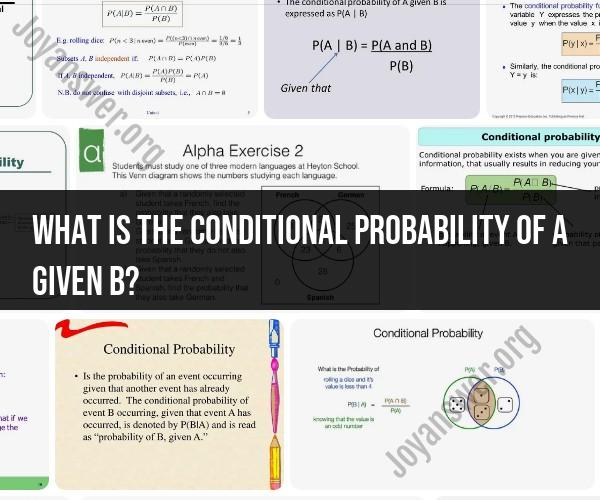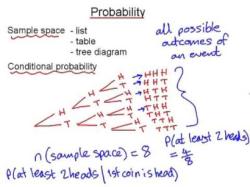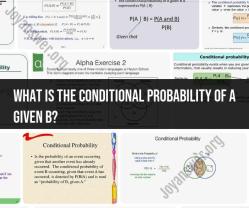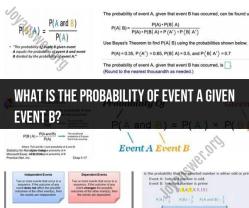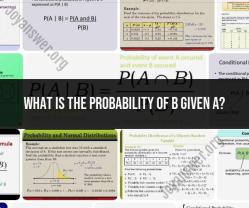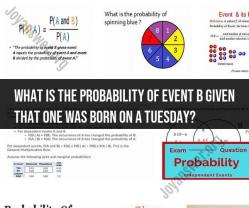What is the conditional probability of a given B?
Conditional probability, denoted as P(A|B), represents the probability of event A occurring given that event B has occurred. In other words, it quantifies the likelihood of event A happening when we already know that event B has taken place. The formula for conditional probability is:
Where:
- is the conditional probability of A given B.
- is the probability of both events A and B happening together (the joint probability of A and B).
- is the probability of event B occurring.
Here's a breakdown of the components:
is the probability of both A and B happening together. It represents the intersection of events A and B. To calculate this, you would multiply the individual probabilities of A and B if the events are independent. If the events are not independent, you would need to use appropriate methods to determine their joint probability.
is the probability of event B occurring, irrespective of whether event A happens. It serves as the normalization factor to account for the likelihood of B happening.
In practical terms, conditional probability allows us to update our knowledge about the probability of an event (A) based on new information or the occurrence of another event (B). For example, consider the following scenarios:
Weather Forecast: What is the probability of rain (A) given that the sky is cloudy (B)? In this case, P(A|B) represents the conditional probability of rain when the sky is cloudy.
Disease Diagnosis: What is the probability of a patient having a particular disease (A) given that they have tested positive for a specific symptom (B)? Here, P(A|B) represents the conditional probability of having the disease when the symptom is present.
Card Games: What is the probability of drawing a face card (A) from a deck of cards given that you have already drawn an ace (B)? In this case, P(A|B) represents the conditional probability of drawing a face card after drawing an ace.
Conditional probability is a fundamental concept in probability theory and has many practical applications in fields such as statistics, machine learning, and decision-making, where we need to make informed predictions based on available information.
What is the concept of conditional probability, and how is it calculated for an event given another event (B|A)?
Conditional probability is the probability of one event happening, given that another event has already happened. It is written as P(B|A), which is read as "the probability of B given A".
To calculate the conditional probability of B given A, we use the following formula:
P(B|A) = P(A and B) / P(A)
where:
- P(B|A) is the conditional probability of event B happening, given that event A has already happened.
- P(A and B) is the probability of both events A and B happening.
- P(A) is the probability of event A happening.
How to work with conditional probability in probability theory and statistics?
Conditional probability is a powerful tool that can be used to solve a variety of problems in probability theory and statistics. For example, we can use conditional probability to:
- Calculate the probability of a disease given a certain symptom.
- Calculate the probability of a customer buying a product given that they have visited the company's website.
- Calculate the probability of a team winning a game given that they are playing at home.
What is the practical application of conditional probability in real-world scenarios?
Conditional probability has a wide range of practical applications in the real world. For example, it is used in:
- Insurance: Insurance companies use conditional probability to calculate the risk of insuring different types of people and property.
- Medicine: Doctors use conditional probability to diagnose diseases and to recommend treatments.
- Business: Businesses use conditional probability to make decisions about marketing, pricing, and inventory.
- Law: Lawyers use conditional probability to evaluate evidence and to build their cases.
Here is an example of how conditional probability can be used in a real-world scenario:
A doctor is trying to diagnose a patient who has a cough. The doctor knows that 90% of people with a cough have a cold, and 10% of people with a cough have the flu. The doctor also knows that 20% of people with a cold have a fever, and 50% of people with the flu have a fever.
The doctor wants to know the probability that the patient has the flu given that they have a cough. To calculate this, we can use the following formula:
P(flu|cough) = P(flu and cough) / P(cough)
We know that P(flu and cough) is 50%, because 50% of people with the flu have a cough. We also know that P(cough) is 90%, because 90% of people with a cough have a cold.
Substituting these values into the formula, we get:
P(flu|cough) = 50% / 90% = 5/9
Therefore, the probability that the patient has the flu given that they have a cough is 5/9.
Overall, conditional probability is a powerful tool that can be used to solve a variety of problems in probability theory, statistics, and the real world.
